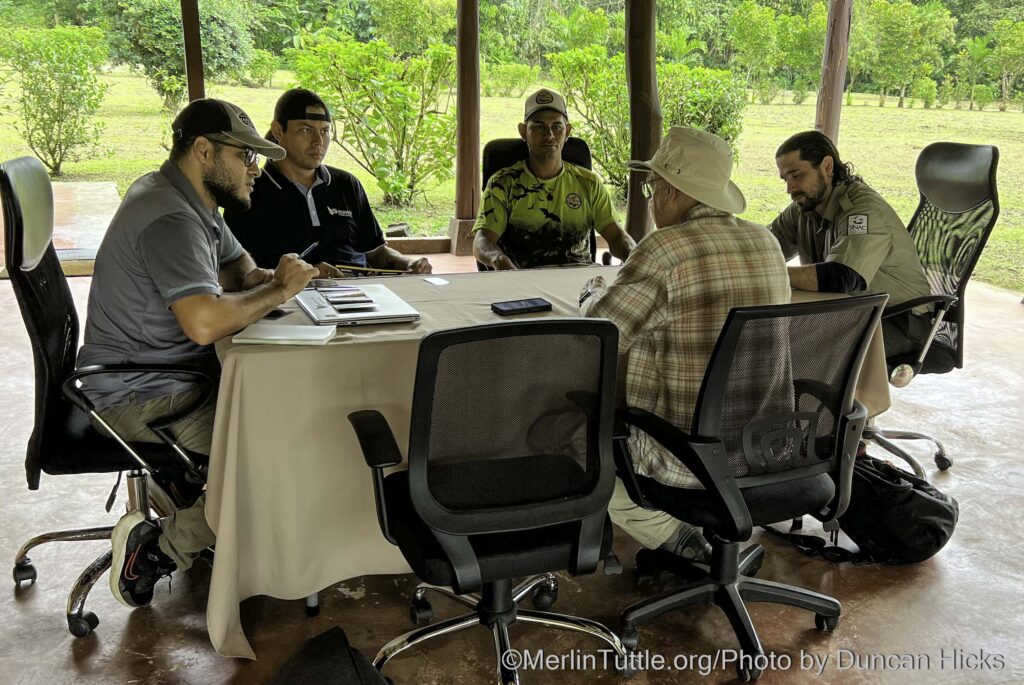The Costs of Bat Decline
Can we afford to lose bats? A recent study by Eyal Frank of the University of Chicago reveals that the dramatic decline in U.S. bat
On arrival at the Selva Verde Eco Lodge in Costa Rica, Merlin and I immediately noticed an unexpected sight – a bat house with a sign and logo prepared by our soon-to-be guide and friend, “Bat Henry.” Our mission would have been impossible without his experienced guidance. His work is a testament to the power of community scientist volunteers.
Upon meeting him, the first thing we noticed about Henry was his bright, highlighter yellow t-shirt with white tent-making bats on the front and a large bat house on stilts on the back. The bat house was Henry’s own design, capable of holding up to 500 bats. Our next insight was his seemingly endless energy and enthusiasm. Despite spending a week in the humid, tropical rainforest with him, I can’t recall ever seeing him detectably tired.
Such energy is vital considering everything he does! Before and after shifts as a lodge gardener 3 to 4 days a week, he devotes his time to helping both people and bats. He volunteers with bat rescues, conducts weekly checks of bat houses, and provides intensive bat care 2 or 3 times a month if needed – only sleeping 15 minutes every 5 hours for up to three days at a time! At Selva Verde, he cares for bats in both forests and bungalows. At Lapa Verde he gives monthly talks to university students and builds bat houses. Both lodges sometimes give him a small fee for his time.
He also does environmental education work for school children and people from nearby villages. He explains how people benefit from helping bats (reducing mosquitoes and other pests and keeping forests healthy). But he is also quick to assist people in solving problems when bats become a nuisance, even making house calls when bats inadvertently enter human living quarters.
Most requests for his assistance result from too many insect-, fruit-, or nectar-eating bats attempting to form large colonies in buildings. Insect-eating species can number in the hundreds or even thousands. In such instances their droppings and/or vocalizations can cause problems. However, they bite people only in self-defense if handled. Such bats would normally be mistaken for vampires and killed, but if safely evicted, they can become invaluable neighbors! Thanks to Henry’s tireless efforts, more and more people are overcoming needless fear and even inviting bats into their neighborhoods by providing bat houses. In helping people solve real, or even perceived problems, and explaining the many benefits of protecting bats, Henry is providing an outstanding example of the effectiveness of saving bats by winning friends instead of battles.
To date, he has helped evict and provide alternate homes for more than 2,000 bats from 15 locations.

Thanks to his extensive experience, Henry has become an expert at finding bats, including some of the least seen species. Soon after our arrival, he led us to a shallow cavity in the hollow base of a fallen tree stump deep in the rain forest. It was occupied by five seldom seen chestnut sac-winged bats (Cormura brevirostris). They were virtually invisible, resembling shingles as they roosted in an overlapping group. Their color almost perfectly matched that of the stump. In fact, it took Henry several minutes to help us see them even from just three meters away!
MTBC member and colleague, Daniel Hargreaves, provided the trip highlight when he purchased and donated Henry’s first power tools for bat house building, including a table saw. We additionally contributed a signed copy of “The Bat House Guide,” and Merlin explained how best to exclude snakes and other bat-eating predators from climbing into his houses.
We are additionally preparing a video on Costa Rican bats, which we hope to share with Henry and his government supervisors to further aid their efforts.
Love our content? Support us by sharing it!
Can we afford to lose bats? A recent study by Eyal Frank of the University of Chicago reveals that the dramatic decline in U.S. bat
Bats are among the most fascinating yet misunderstood creatures in the natural world, and for many conservationists, a single experience can ignite a lifelong passion
Many bat conservationists know that Kasanka National Park in Zambia is an exceptional place for bats, but it is also the place that sparked my
The Kasanka Trust is a non-profit charitable institution, which secures the future of biodiversity in Kasanka National Park in Zambia. They welcome internships for students
2024 © Merlin Tuttle’s Bat Conservation. All rights reserved.
Madelline Mathis has a degree in environmental studies from Rollins College and a passion for wildlife conservation. She is an outstanding nature photographer who has worked extensively with Merlin and other MTBC staff studying and photographing bats in Mozambique, Cuba, Costa Rica, and Texas. Following college graduation, she was employed as an environmental specialist for the Florida Department of Environmental Protection. She subsequently founded the Florida chapter of the International DarkSky Association and currently serves on the board of DarkSky Texas. She also serves on the board of Houston Wilderness and was appointed to the Austin Water Resource Community Planning Task Force.
Michael Lazari Karapetian has over twenty years of investment management experience. He has a degree in business management, is a certified NBA agent, and gained early experience as a money manager for the Bank of America where he established model portfolios for high-net-worth clients. In 2003 he founded Lazari Capital Management, Inc. and Lazari Asset Management, Inc. He is President and CIO of both and manages over a half a billion in assets. In his personal time he champions philanthropic causes. He serves on the board of Moravian College and has a strong affinity for wildlife, both funding and volunteering on behalf of endangered species.